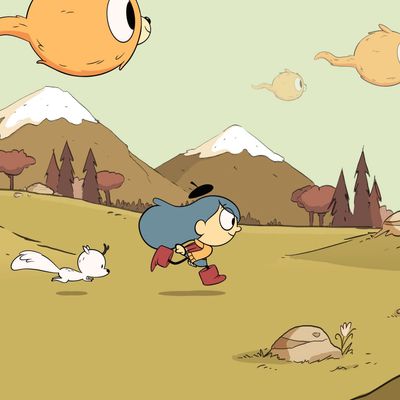
It is time for you to feast upon a tale of adventure in a chill land filled with the beasts of central and northern European mythology. Its plucky protagonist escapes many an ill fate nearly delivered by the claws and jaws of monsters and holds an uneasy alliance with a consortium of witches. The fate of the world may very well be placed in the hands of one special child. And its second season is streaming on Netflix right now.
No, The Witcher season two hasn’t dropped yet. You thought this was about The Witcher? Clearly you need to start watching Hilda.
Adapted from the award-winning British graphic-novel series by Luke Pearson and boasting a theme song by Grimes and the voice talent of Bella Ramsey — none other than Lyanna Mormont, the Lady of Bear Island, herself — as the eponymous blue-haired heroine, Hilda, a bafflingly unheralded all-ages series, is one of Netflix’s hidden gems. Aside from the above connections, the series is about as far from The Witcher as one can get, filled with gentle landscapes and heartwarming story lines.
Even when Hilda and her friends — a deer-fox pup (or is it a fawn? Unclear); a tiny paperwork-loving elf; a woodman who looks like he walked out of a Deku Scrub community from Nintendo’s Legend of Zelda series; a friendly household spirit called a nisse; and a couple other human children, her Sparrow Scout troop-mates Frida and David — are braving the grasping arms of trolls, the maws of dragons, and the feet of giants, the show radiates warmth. Besides, stuck as they are in a once-wild world now overrun by humans, the trolls just want to be left alone, the dragons are suffering from social anxiety, and the giants just miss their friends. Have a little empathy!
Hilda is, in fact, the perfect winter show, and not just because it’s obsessed with Nordic folklore and, specifically, Nordic yuletide traditions. The series is perfect for winter because it understands intimately that mood so beloved by the Danish, the Norwegians, and influencers in that long-ago year of 2016: hygge.
Oxford Dictionaries define hygge as “a quality of coziness and comfortable conviviality that engenders a feeling of contentment or well-being (regarded as a defining characteristic of Danish culture).” That is Hilda to a T. Even without the bestiaries of Danish and Norwegian folktales ever-present in the story, the Nordic undertones in Hilda would be perfectly obvious. This is a series whose premiere sees an 11-year-old girl broker an accord with a kingdom of miniature bureaucratic elves so that she and her graphic designer mum (oh, right — the characters all speak with British accents) can enjoy a roaring fire in their lovely country cottage and play a board game in peace. The main character’s favorite food is cucumber sandwiches, and her favorite drink is peppermint tea. It’s definitionally cozy.
Which is not to say that the show has no conflict. Hilda is an adventurous child, after all, and her courage comes with a headstrong attitude that gets her into occasional trouble. Plus, of course, there are witches and trolls and spirits all over the place, and human settlements inevitably have their issues coexisting with such a world. But Hilda, like Hilda, is all about open-mindedness. She is as dedicated to resolving conflict and living in peace as she is to her curious approach to the world.
Hilda is a child, and as a child, she approaches a world filled with marvels with the appropriate level of amazement. The adults of Trolberg, her adopted hometown, are not so accepting. They see the spirits and monsters among them and their response is to shut them out to protect their children, like Hilda’s mum Johanna, or to fight them off in the name of safety, like the Trolberg Safety Patrol, the town’s police force. But Hilda doesn’t fight monsters. She talks with them. She takes them as they are. She finds a way to not just coexist, but to cooperate. Most of the time, it works.
Stylistically, too, there’s comfort here. Visually, the series strikes a balance between the vibrant, earthy style of Pearson’s comics and the soft, pastel-seeped loveliness of Steven Universe, with just a dash of Peanuts character design thrown in. The nature of the magical world feels similar to that of Gravity Falls, but with more emphasis on wonder than on unraveling a mystery. The characters are as figuratively wide-eyed as they are physically.
Combined, these elements make for a perfect winter evening, and the series knows it, too. Hilda loves her escapades as much as viewers do, and the show has a genuine emotional depth that can, at times, bring a viewer — or at least this viewer — to tears. But when the day is through, Hilda wants to curl up with a cup of tea beside her mum and her friends and play a friendly game of Dragon Panic, a thinly veiled Settlers of Catan stand-in. It’s all hygge, through and through. Just like curling up with a cup of tea — peppermint, preferably — and watching Hilda.




